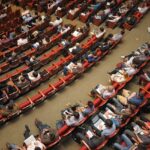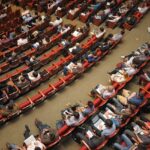Because we speak quite a bit at Swift Kick, and because we work on the new stuff, where abstraction is common, “vision” is everywhere, and hard experience is limited, we love the analogy.
We love to ground the new in the schema of the old. This is just what effective teachers do all the time. This is what learning is, I’ll come back to this.
An analogy is also wonderful for innovation. It’s more fluid to think in familiar patterns.
Every once in a while we find an analogy that “has legs.” Meaning it gets more interesting the more you play with it. Dance floors are one of those analogies and we’ve been playing and learning in that one for almost three years now.
Through the analogy, one can come up with new and interesting ideas that would not have been visible without the analogy.
Going back to learning . . .
We store information in patterns – little neurological patterns in various parts of the brain: “long tail” over there, “folksonomy” on the other side, “social graph” somewhere else, all attached to the larger pattern of “web 2.0” in my head. Through the interconnections of these sub-patterns “web 2.0” becomes an operational concept. I can use the embedded sub-patterns summarized by “web 2.0” to think about things and to understand new ideas that come to me.
Take Twitter.
Twitter is insane unless you’ve been networked learning for a bit, or Facebook status-ing – it would be these activities that would provide one with an existing pattern in which to attach and weave the new concept of Twitter.
I mean literally “insane” – defined in my dictionary as “a state of mind that prevents normal perception, behavior or social interaction.” Insane is a strong form of “unrecognizable pattern.” “I have no idea what you are talking about.” is a milder form of the same thing.
With new ideas, “Insane” is determined by the beholder, or specifically the beholder’s patterns. If the person hearing about Twitter for the first time has the requisite existing patterns, Twitter makes sense and is even exciting. If not, if the learner does not have the existing patterns, Twitter will not be perceivable (there will be nothing to attach it to) and the behavior of the “tweet-ahs” will be inscrutable and appear, well, insane.
Building schema/patterns up to reach understanding is what teachers and curriculum planners call scaffolding**. The end goal is a series of patterns that become operational, allowing the student to learn more (attach new ideas/patterns) and do things (map patterns into the world).
Scaffolding is done by reverse engineering various patterns necessary for understanding any given concept and building them up in the right order, each pattern connecting to and building on the last.
In short:
Learning is attaching a new idea to an existing pattern.
If a new idea can’t be connected to an existing pattern, that idea will not be learned, in fact, it will often be rejected. (There is typically negative emotion attached to discord or chaotic patterns. Listen to this, it’s the sound of difficult learning, especially if you are missing the “post rock” pattern.)
Good instruction (to teach new ideas) involves identifying requisite patterns and purposely building them in order.
The more one learns the more one can learn. Many patterns, especially diverse patterns in a flexible mind, provide greater surface area for attachment.
Teachers try to check for patterns through testing, to see what new ideas the student is ready for.
The patterns in our heads must be accessible to be useful. It doesn’t help me that a math pattern exists, lost in the basement of my head. If I can’t find it, statistics won’t have anything to stick to and I will have to rebuild the necessary patterns.
————
The above is all just how learning works and how our brains work. Using this scaffolding as an analogy makes “social networking” vastly more interesting.
People operate in the same dynamics at a larger scale. Our social patterns are analogous to our synaptic patterns. Socializing works like thinking.
As individuals, we connect ourselves to social patterns to create our identity (our self-model). Our various contexts, family, work, church, school, etc. are all simply patterns and sub-patterns.
Within a school, there are many existing social patterns.
The degree to which these patterns are intra-connected determines their individual effectiveness as groups. In leadership training, it’s called “team building.” The goal is to make the social pattern more effective in thinking and working together.
The degree to which these patterns are inter-connected determines the effectiveness of the institution as a whole.
Social networking increases the ability of students to retain bridging capital (loose connections) thereby increasing the connectedness and effectiveness of the institutional brain. The institution, by having more patterns, gets better at learning.
Red Rover, building upon social networking, is specifically designed to help with social pattern integration. We learn in a social context. Red Rover is an institutional learning tool.
A first year student is a new idea to the institution. If that student cannot connect to a pattern or multiple patterns, the student is not likely to be retained. The institution won’t “learn” the new student.
By identifying, surfacing, and optimizing social patterns, Red Rover automates the connection and learning process, at the micro and the macro levels.
Once “connected,” other relational factors come into play and students become pass/ fail filters for memes in the network – each according to their individual patterns.
The implications for society are extremely exciting.
By increasing the visibility and effectiveness of social pattern connection we can literally increase the effectiveness of our institutions while simultaneously optimizing the learning of the individuals within those institutions.
With social networking, we can do externally what is nearly impossible internally – we can map, visualize, and systematically optimize our patterns.
It will be fascinating to watch the science of this social graph optimization unfold.
Numerous information patterns, stored in unrelated areas, are not as useful as when they are connected.
Information patterns cannot be predictive about the systems in which they reside until the information is attached within a model. Disconnection creates wasted time and energy. In business, this is called dysfunctional siloing. The lack of a cohesive model is generally the problem with neuroscience today.
Somewhere, at some point, a cohesive unifying social model will become visible. Will it be usefully analogous to the emerging brain model? My money is on yes.




